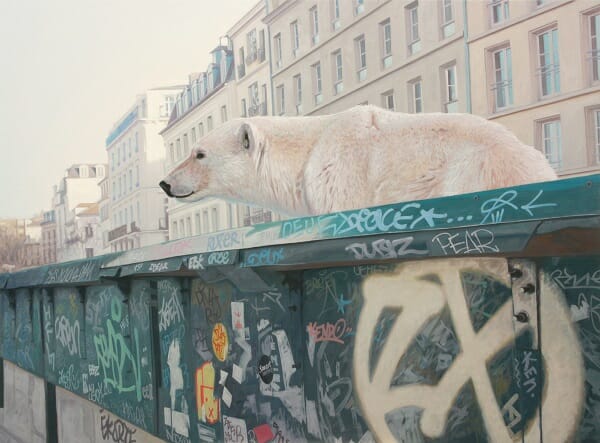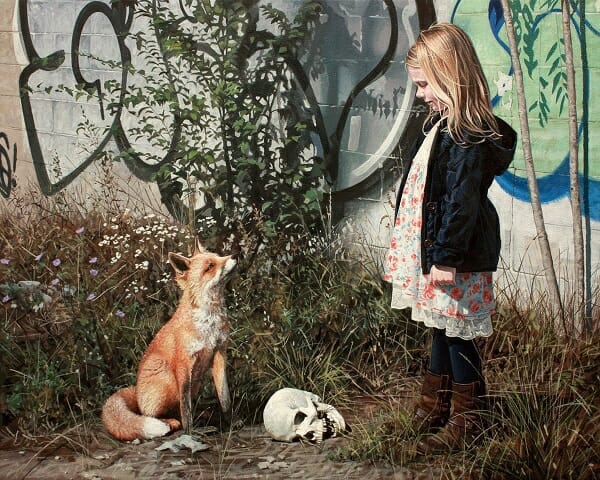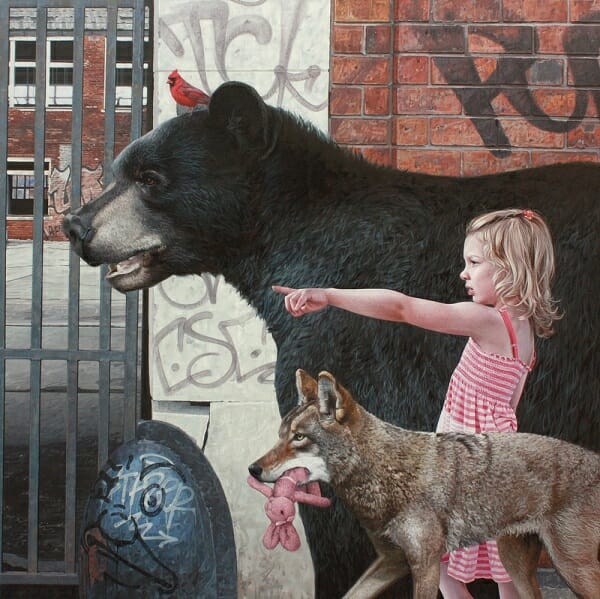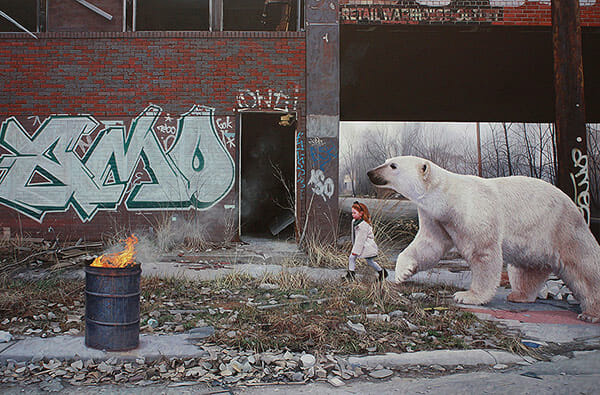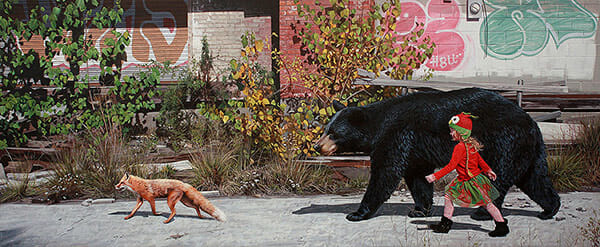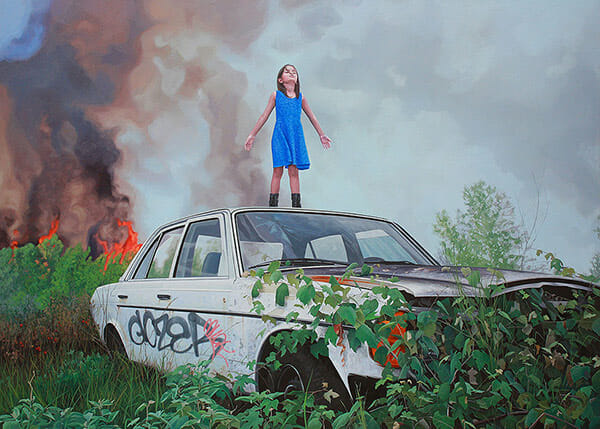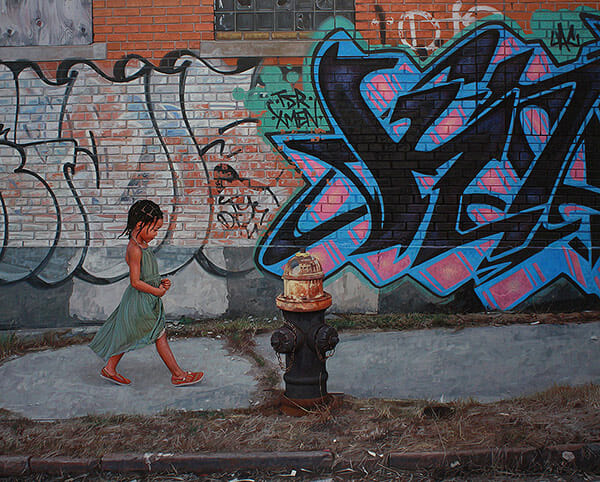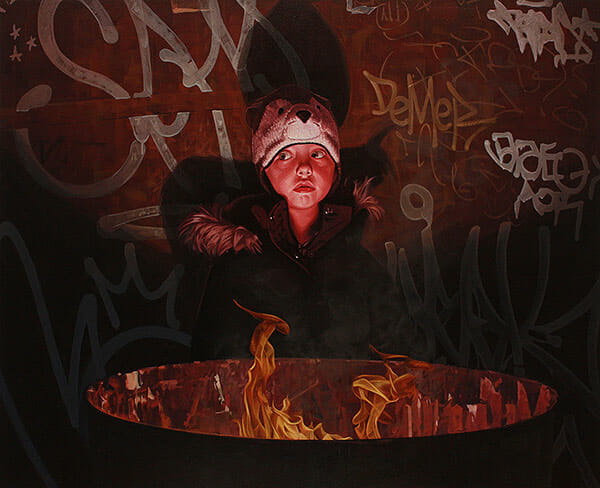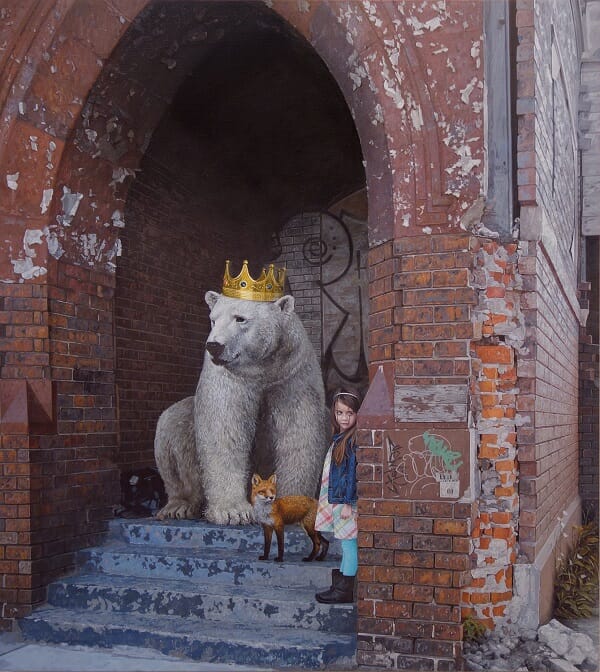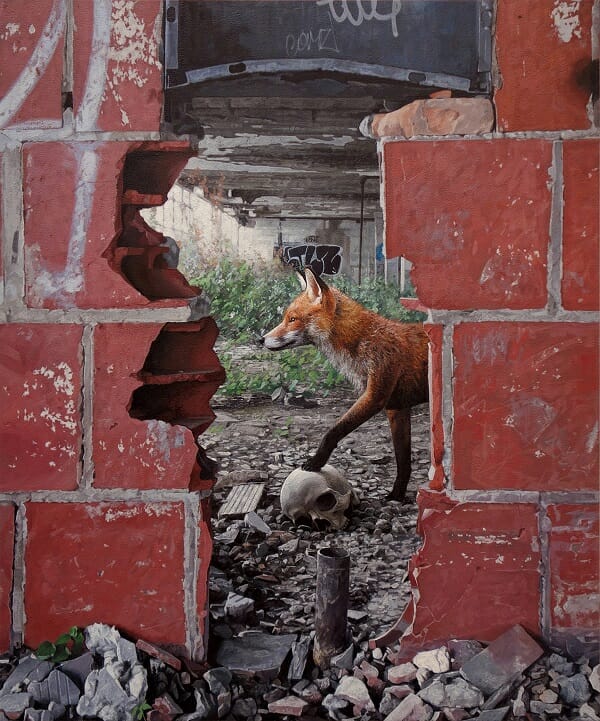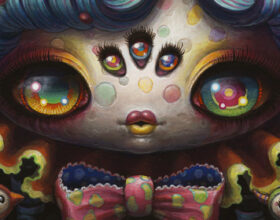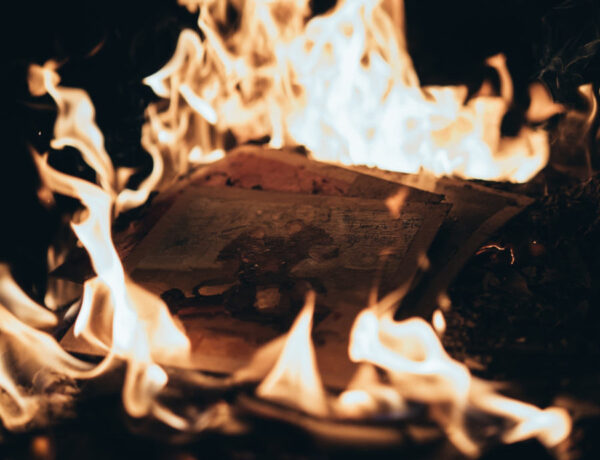We humans are born most innocent, yet hastily our clean lives get messy as the world’s bombardments begin to pelt us from every angle. And who better to illustrate this story than Houston, Texas-based painter Kevin Peterson, who presents his youthful subjects within a threatening (yet somehow serene) context of fire, decay, graffiti, and trash. Garnering grit from the animals who stride, fly, and trot alongside them, the artist’s children appear unperturbed by their crumbling surroundings, their spirits bolstered by their furried and feathered friends. The lack of fear in these kids represents the strength we all have, and the outlook that we’ll survive adversity and be better people on the other side.
“It’s impossible to say how something will affect you until after you’ve been through it,” Kevin states, “and that’s what makes it so interesting to me.”
Kevin Peterson interview conducted in conjunction with his editorial in Issue 021 of Beautiful Bizarre Magazine. We hope you enjoy!
Kevin Peterson
Greetings Kevin, thanks for speaking with me today. Let’s start out with the quote on your Instagram profile: “…and then the world starts in on us.” This statement in relation to your work can be interpreted as ‘we are born innocent, perhaps even fortunate enough to be a part of a desirable family system, then our clean slates are scribbled upon, marred by trauma, and scratched by injuries and emotional jabs. Can you give us a couple of examples of worldly ‘beatings’ from your own childhood or adolescence?
I moved around a lot as a kid. This meant leaving friends, starting new schools. I was very shy and quiet so this was extremely difficult for me. Overall, I have had a relatively privileged life, but no matter what your background there are always those events that leave little psychic scars. Even if you don’t remember them all, they are there.
Second part to the above question: can you look back on any of these events and see any evidence of an upside?
Yes, absolutely. If you make it through, you are stronger for it. Maybe stronger isn’t the right word. You may be changed in some way, maybe you have new defenses or whatever but you are deeper and will be capable of more introspection or empathy in the future. These things make you who you are.
Although they are surrounded by threats represented by fire, decay, graffiti, debris, trash, peeling paint, and crumbling stone, the children (in most of your paintings) appear unperturbed by their surroundings. I recall you once called their expressions “contemplative.” Do the animals who accompany these children represent (at least in part) the resiliency of childhood?
Yes, and that is the hopeful aspect of my work. Sometimes the work may seem a bit dark and i suppose it is, but the lack of fear in these kids is what represents the strength we all have, and the outlook that we will get through this and be better people on the other side.
Let’s talk symbolism for a moment. Sometimes you have the animals donning crowns and sometimes it is the children. What does the crown symbolize for you?
The crowns symbolize a hopeful change in our current priorities as a culture. Honoring our children and our environment. I don’t understand why we choose to neglect either one considering how important they are to the future.
Have you ever seen a hummingbird nest – that meticulously assembled, tiny hodgepodge – at rest in its tree, swaying back and forth in a windstorm? Teetering in its crook of thin branches, the furry cup dips and sways, small but solid, reacting but not succumbing to the relentless forces of nature. The nest in the storm is a metaphor for childhood, a time in life when we are small but mighty, capable of more than what meets the eye. Have you ever had an image that stuck with you, that you felt illustrated in symbol something more powerful that could be said in words?
One thing I see sometimes that always strikes me is that weed that finds a way to grow out of a tiny crack in the concrete or the middle of the asphalt. It has no business thriving there but it finds a way. That weed is some kids growing up in this world.
The American band The Red Hot Chili Peppers chose your painting “Coalition II” for the cover art for their 2016 album, The Getaway. Lead singer Anthony Kiedis was quoted as saying the painting felt “extremely warm and human, even though it’s animals.” Kiedis also stated that the subjects in Coalition felt like they represented each member of the band: “Chad (drummer) is the bear, Josh (guitarist) is the girl, and Flea (bassist/pianist) is the raccoon, and me as the funny little raven out front.” When you compose a painting, are you ever thinking of representing groups of people you know – famous or not – in the piece? Say, a family you know, or the characters in a favorite movie? Or is it more like disparate people assembled together in a piece to form a collective whole?
Using different races of models and animals from different parts of the world adds different layers for sure and that is something I think about, but I usually don’t set out to depict one specific person. I want the pieces to be relatable to a broad range of viewers.
Now let’s shift a bit and talk about the themes in your paintings. I see a parallel within the themes you explore and those presented in the 1996 novel by Philip Pullman titled, “The Golden Compass” (each child has a daemon familiar; an animal companion/extension of their personality), and the 2002 New Zealand-German film “Whale Rider.” In the latter, the main character states, “I know that our people will keep going forward, all together, with all of our strength.” Both of these sources feature children who harness the power of animals to solve a major conflict, while coming out of the experience with renewed confidence and worldly wisdom. Do you have a favorite film or novel that resonated with you?
Golden Compass has been brought to my attention a bunch of times but I’m not familiar with it at all. I love the imagery in Terrence Malik films. I really liked the recent film “Moonlight”. I love how the film “Adaptation” dissects the creative process. David Foster Wallaces writing about depression and recovery has meant a lot to me. ” A Visit From the Goon Squad” by Jennifer Egan, “The Goldfinch” by Donna Tart and I thought “Life of Pi” was pretty brilliant.
“Post traumatic growth” is an area of psychological study first explored in the 90’s wherein survivors report a series of positive outcomes – a new appreciation for life, a newfound sense of personal strength and a new focus on helping others – following horrific experiences such as car accidents. In what ways (if any) do you feel your works explore the topics of PTG?
Let’s discuss reactions to your work. In many of your paintings, the child and his or her animal tribes folk are all walking toward some unseen future, in what appears to be a united front, their momentum palpable, an invisible force garnered from their conjoined spirits. Together, the posse is endowed with the speed and agility of the birds, the massivity and brute strength of the bears, the cleverness of the foxes and raccoons, and the natural resilience and innocence of childhood. The child is portrayed honestly, clothes wrinkled, hair unkempt, but in the company of her tribe, she is a force to be reckoned with. These are evocative themes that stir the soul. Can you describe a time when a fan reacted powerfully to your work? How did it make you feel?
I get personal emails from people telling me about trauma in their life and that my work has meaning to them. It’s really amazing that people will take the time to let me know that something I made has had an effect on them. It means a lot to me.
In your Artist Statement you wrote, “My work deals with isolation, loneliness and longing teamed with a level of optimistic hope.” Your subjects are contemplating a world where things are crumbling, but they are facing it head on, and in a positive light. Based on the feedback you’ve been receiving, is this message of positive thinking getting through to your viewers?
For the most part, yes. Sometimes I feel that the work may be getting a bit too dark for some people, but that’s OK. There is no such thing as art that everyone likes, and no artist should even attempt to make art that does. I do occasional commission work with people, and sometimes a clients ideas are kids smiling and playing and having fun with an animal or something like that. These type of ideas don’t work for me. Happiness is great, but when it comes to happiness, I have two feelings: one, if you don’t experience struggle, then you will never truly understand happiness; and two, happiness makes boring art- the struggle is what interests me.
Regarding intention, what discussions do you hope to initiate with your work?
Care for our future generations. What type of world are we leaving for them? What happened in our lives that made us the people we are as adult?
A recent comment from one of your Instagram followers: “Love the empowerment of children in your work — think too often they’re portrayed as victims or weak – they seem both themselves and strong in your paintings.” In an age where superhero films are all the rage, it is refreshing to look at your work and see what can be described as “real, everyday heroes,” the little ones who endure (even thrive among) bullying, oppressive parenting, physical and emotional abuse, hunger. Why are you compelled to sing the song of the unseen hero?
I guess because there is no such thing as superheros. It would be easy to make it through life with some super power or supernatural abilities but none of us have that and so we have to figure out how to do it with what we have. That is actually more impressive to me.
Many of your compositions, especially “Megan” and “Funeral,” stir an emphatic response in the viewer. In today’s world, in which we are “connected yet disconnected” by smartphones and the internet, reminding people to feel for each other is important work. Is it part of your artistic intention to remind others to be compassionate?
Yeah I think so. Empathy is really something that strikes me as lacking in this world, especially here in the states right now. I’m unsure how you can teach an adult empathy and its sad that we even have to, but I guess art is as good a way as any to try and evoke that response.
On a more personal note, it can be posited that every subject on a canvas is (in part) a reflection of the artist’s identity. If you were to focus wholly on yourself, at this point in your life, what might that composition (in a painting) look like and what animals would be in your tribe and why?
I made my own tribe now. It would be me with a puma (my wife) a raccoon (my son) and a maybe my daughter would be a cute, chubby, and happy baby hippo.
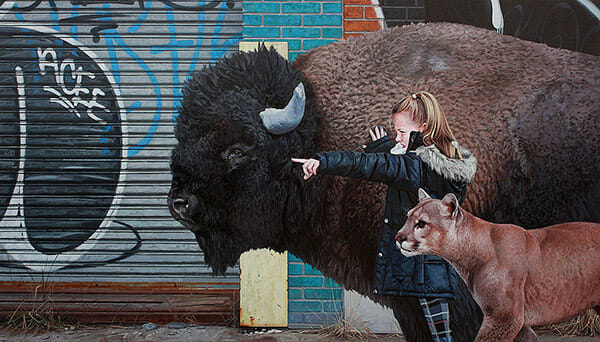
What if you were asked to compose a painting (in your current style) that represented you 17 years ago when you first received your BFA? Describe that painting.
Uhggg, lonely, scared, depressed, alcoholic, addict. Lacking hope for sure. Not the best time in my life. That would be a dark painting. I’m grateful for those years though. You can not appreciate the light without knowing darkness. I’ve been sober for nearly 13 years and am better adjusted than I was then.
Your paintings explore the idea of personal strength. What do you do when you are feeling weak, and what makes you feel powerful?
I only have one trick- I paint.
Deer, crows, polar bears, foxes, lionesses, black bears, raccoons. It must be asked: what is your favorite animal (or favorite two) and why?
I never met an animal I didn’t like. I seriously couldn’t pick just one or two- black bears, polar bears, all types of cats, raccoons, rabbits, foxes, crows.
Your paintings communicate a deeper appreciation of “the little things,” and convey a (sometimes subliminal, sometimes apparent) message of interconnectedness between humans and animals. Describe the relationship you had with an animal you were very close to.
Oh man, I had about every kind of pet you can imagine growing up. I’ve always loved animals. Usually more than people! My dog Trigger was with me through a very tumultuous time in my life. High highs and low lows, he was my partner, he was with me all the time, I loved that guy so much. He actually also introduced me to my wife. When he got sick I was referred to a vet specialist and she was his doctor and we eventually got married! Yeah so my wife is a veterinarian, so it’s safe to say animals are important to us.
Let’s talk about your childhood. One of the great things about natural history museums are the full size dioramas in which the animals are showcased in their native surroundings, sans the confinement barriers (bars, walls, chain link fences) one must usually look through when viewing animals at a zoo. You can stand in close proximity to the animals and really stare at them, and if the taxidermy is good, the illusion of reality, when coupled with an active imagination, results in a fully immersive, “portal-like” experience, transporting you into the animal’s world. Do you remember visiting full size dioramas like this as a child, and/or have you visited them lately? What effect did they/do they have on you?
Yeah I do, they always seem off to me. Something about taxidermy, it’s never quite right. It’s like they try so hard to make these stuffed animals lifelike, but the soul is gone. That spark is not there, and everyone can see it. I think that’s why I like painting. My goal is for my subjects to look alive, to try and capture that soul as best as I can in two dimensions.
Your work is about relationships: to our environment, to our inner child, to the animals around us as well as to what those animals represent. What would you say were two influential relationships you had when you were a child?
Probably my relationship with my brother. We went through everything together and we had to be there for each other. I would say the other important relationship for me was my relationship with art. Drawing and painting helped me get through rough times as a kid and it still serves that purpose today.
Kevin Peterson Social Media Accounts
Website | Facebook | Instagram
Related Articles
What Advice Would You Give On How To Get Gallery Representation?
Gaia Reborn: An Exclusive Interview with Danijela Krha Purssey & Yasha Young of Urban Nation



